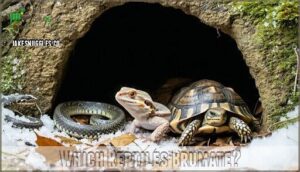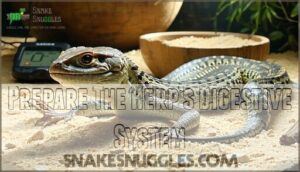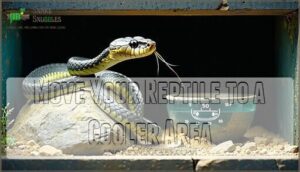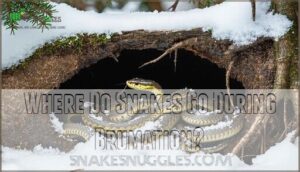This site is supported by our readers. We may earn a commission, at no cost to you, if you purchase through links.

Think of it like your morning routine – when it’s too chilly, you’re not exactly keen to jump out of bed either.
Cold-blooded creatures can’t regulate their body temperature like you do, so they literally slow down as temperatures drop.
Some tropical species get sluggish at 60°F, while hardier varieties tough it out until temps hit the 40s.
They don’t truly hibernate but enter brumation – nature’s version of a cozy winter nap, which is essential for understanding safety and how snakes behave in different temperatures, especially when they reach certain temperature thresholds, and it’s crucial to know that they slow down as temperatures drop, entering a state of cold-blooded inactivity.
Table Of Contents
- Key Takeaways
- What Temperature Do Snakes Become Inactive?
- What is The Coldest Temperature a Snake Can Withstand?
- Which Reptiles Brumate?
- Do You Own a Reptile as a Pet?
- How to Prepare Your Herp for Brumation
- How Do Snakes Hibernate?
- Where Do Snakes Go During Brumation?
- What This Means for You and Your Business
- Snake Control for Businesses
- Frequently Asked Questions (FAQs)
- When do snakes become inactive?
- What temperature does a snake get sluggish?
- What temperature does a snake become inactive?
- What happens if a snake gets cold?
- When do snakes become sluggish & less active?
- How cold can a snake survive?
- What temperature is too cold for a snake?
- Are snakes active at 50 degrees?
- Do snakes stop moving when cold?
- At what temperature do snakes become inactive?
- Conclusion
Key Takeaways
- You’ll see snakes become inactive when temperatures drop below 60°F – this is when their cold-blooded bodies can’t regulate heat anymore, forcing them into a sluggish state that leads to brumation (their version of hibernation).
- Most snakes can’t survive prolonged exposure below 50°F, and anything under 32°F is typically fatal – while some hardy species tolerate brief cold snaps, extended freezing temperatures mean death for these reptiles.
- You’ll find inactive snakes hiding in underground burrows, rock crevices, tree stumps, and shared dens – they seek these hibernacula (winter shelters) to maintain stable temperatures and conserve energy throughout the dormant period.
- If you own a pet reptile, you’ll need to prepare them for brumation by stopping food 14 days beforehand and gradually cooling their environment to 50-68°F – this prevents digestive complications and mimics natural temperature changes for safe dormancy.
What Temperature Do Snakes Become Inactive?
Most snakes hit the brakes when temperatures drop below 60 degrees Fahrenheit. This minimum activity temperature triggers their survival mode because they can’t regulate body heat like you do. Think of it as nature’s thermostat shutting down their engine.
When winter’s chill hits 60°F, snakes basically hit the snooze button on life until spring warms things up again.
The snake temperature range for activity typically spans 68-80°F, with their optimal temperature range between 70-90°F. Below this minimum snake temperature, you’ll notice dramatically reduced movement. Species cold tolerance varies, but fatal temperature drops below 50°F can spell trouble.
These brumation triggers force snakes into low temperature snake activity or complete dormancy. Understanding snake inactivity temperature thresholds helps you predict when these reptiles become sluggish and seek shelter in dens, caves, or warm hiding spots.
What is The Coldest Temperature a Snake Can Withstand?
While understanding snake inactivity temperature is vital, knowing lethal temperatures can be life-or-death information for snake encounters and pet care.
Most snakes can survive brief exposure to temperatures around 40°F, but their cold tolerance varies dramatically by species and geographic influence. However, when temperatures drop below freezing for extended periods, you’re looking at potentially fatal conditions.
Here’s what determines a snake’s minimum snake temperature survival:
- Species variation – Northern species tolerate colder temperatures than tropical ones
- Gradual vs. sudden drops – Slow temperature changes allow better adaptation
- Duration of exposure – Brief cold snaps are survivable; prolonged freeze isn’t
- Access to shelter – Snakes need protected areas for brumation survival
The harsh reality? Prolonged exposure below 32°F typically means death for most snake species.
**Below freezing? That’s a death sentence for most snakes—their cold tolerance simply can’t handle the freeze.
Snakes require external warmth, because temperatures below 65°F are generally too cold.
Their snake temperature tolerance simply can’t handle extended snake freeze conditions without proper shelter.
Which Reptiles Brumate?
Regarding reptile behavior during cold temperatures, you’ll find that several species enter brumation—nature’s version of hitting the pause button.
This dormancy helps them survive harsh winters when food becomes scarce and temperatures plummet.
Most temperate-climate reptiles brumate, but the list might surprise you:
- Snakes: From garter snakes to rattlesnakes, they seek shared dens for warmth
- Lizards: Bearded dragons and leopard geckos dramatically slow their activity
- Turtles and Tortoises: These shelled creatures dig deep burrows for protection
Brumation triggers include dropping temperatures and shorter daylight hours.
Reptiles in this state experience reduced metabolic rates to conserve energy.
While captive brumation can occur in pet reptiles, tropical reptiles typically don’t brumate due to consistent temperatures in their native habitats.
Regional brumation patterns vary—what works in Virginia won’t match Florida’s climate.
Understanding reptile brumation temperature thresholds helps you recognize when your scaly neighbors are settling in for their winter sleep.
Do You Own a Reptile as a Pet?
Owning a reptile means you’re signing up for year-round responsibility, especially when temperatures drop. Reptile care becomes more complex during colder months when your scaly friend’s needs shift dramatically. You’ll need to understand reptile cold tolerance and reptile brumation temperature thresholds to keep your pet healthy.
Reptile owners quickly learn that enclosure setup isn’t a one-size-fits-all situation. Species suitability matters—your ball python won’t handle cold the same way a bearded dragon does. Snake hibernation temperature requirements vary substantially between species, making research non-negotiable.
Don’t wing it when winter approaches. Handling techniques change during cooler periods, and veterinary needs become more specialized. Your reptile depends on you to recognize behavioral changes and temperature sensitivities. Think of yourself as their personal climate control system—because that’s exactly what you are.
Some states require permits and training for venomous snake ownership.
How to Prepare Your Herp for Brumation
Getting your pet reptile ready for brumation isn’t like tucking a child into bed—it requires careful preparation to guarantee your scaly friend survives the dormant period safely.
You’ll need to follow three critical steps: prepare their digestive system by withholding food for two weeks, gradually lower temperatures over several days, and move them to a cooler environment between 50-68°F, which are essential for a safe dormant period.
The goal is to ensure your pet reptile survives the dormant period safely by carefully preparing their environment and care routine.
Prepare The Herp’s Digestive System
Stop feeding your reptile 14 days before brumation begins. Withhold food completely to prevent deadly digestive complications during dormancy.
Make certain defecation occurs by maintaining normal temperatures and providing gentle belly massages. Check parasites beforehand and provide water throughout preparation.
Prior to brumation, this is vital: reptile parasite control. This critical step prevents undigested food from rotting inside your pet’s digestive system, which could prove fatal during their lowered metabolic rate.
The reptile parasite control is essential to prevent undigested food from causing fatal complications.
Acclimate The Reptile to Cooler Temperatures
Gradual cooling mimics nature’s rhythm, helping your reptile’s snake thermal regulation adjust smoothly. Start temperature reduction slowly over 1-2 weeks, dropping ambient temps by 5-10 degrees incrementally to reach 60-70°F. This prevents shock to their reptile body temperature systems while supporting healthy brumation preparation.
Accurate readings from a reptile’s environment matter are crucial for this process.
- Daily checks become your reptile’s lifeline during this critical period
- Monitoring weight reveals hidden stress that could endanger your pet’s survival
- Humidity control protects delicate respiratory systems from dangerous drying out
- Snake metabolism temperature changes trigger life-or-death physiological responses
- Snake active temperature thresholds determine whether your reptile thrives or suffers
Move Your Reptile to a Cooler Area
After gradual cooling, relocate your reptile to its designated brumation area.
Choose spaces between 50-68°F like basements or spare rooms for ideal snake metabolism temperature regulation. Position the enclosure placement away from heat sources while maintaining humidity control with a shallow water dish.
Consider upgrading your snake’s habitat needs before brumation.
Monitor your pet’s reptile body temperature daily during this safe shift to support natural snake thermal regulation.
How Do Snakes Hibernate?
Once you’ve prepped your reptile properly, understanding brumation explained becomes fascinating. Unlike true hibernation, snakes don’t completely shut down during winter dormancy. Think of it as nature’s energy-saving mode – their metabolic slowdown reduces breathing and heart rate to barely detectable levels.
During this dormancy period, snakes become living statues. Their snake behavior shifts dramatically as cold temperatures trigger hormonal changes. You’ll find them seeking hibernacula details in underground dens, rock crevices, or hollow logs below the frost line.
Here’s what makes winter survival remarkable:
- Snakes can survive months without eating a single meal
- Their body temperature drops to match their surroundings exactly
- Heart rates slow from 60 beats per minute to just 10
- They remain semiconscious, unlike hibernating mammals
- Multiple species often share the same cozy winter den
This dormant state isn’t sleep – it’s sophisticated biological engineering.
Where Do Snakes Go During Brumation?
When winter arrives, snakes don’t just disappear—they find clever hiding spots called hibernacula. Den selection becomes critical as temperatures drop below their snake dormancy temperature of 60°F.
You’ll find them in underground burrows, rock crevices, tree stumps, and caves. Burrow depth matters too; deeper means more stable temperatures during winter dormancy.
Many species create shared dens, huddling together like nature’s heating system. Urban shelters include basements, crawl spaces, and storm drains. These brumation hideouts protect snakes from freezing while maintaining just enough warmth to survive.
Snake Den Sites Winter Benefit
hibernacula
What This Means for You and Your Business
Understanding snake temperature thresholds directly impacts your Business Impact and operations.
When temperatures drop below 60°F, snake activity virtually stops, reducing snake encounters and improving Customer Safety.
However, don’t let your guard down completely.
Cold weather creates a false sense of security that can lead to Liability Concerns.
Snakes may still emerge during unexpected warm spells, catching everyone off-guard.
Your Prevention Strategies should remain active year-round:
- Maintain clean walkways free of debris and tall grass
- Use walking sticks to create vibrations that alert hidden snakes
- Seal building entry points where snakes might seek shelter
- Control rodent populations that attract hungry snakes
Employee Training on snake behavior and temperature patterns keeps your team prepared.
Even dormant snakes can pose risks if disturbed in their winter shelters.
Smart business safety means staying vigilant regardless of season, because one snake encounter can disrupt operations and alarm customers.
Snake Control for Businesses
Running a business means you’ll occasionally face snake intrusions that can create serious Business Liability Concerns. Smart Commercial Snake Prevention starts with thorough Employee Training Protocols – teach your staff to recognize snake activity and maintain safe distances.
Implement Customer Safety Measures by keeping walkways clear and well-lit. Repelling Snakes Effectively requires eliminating their food sources, so control rodent populations and remove debris piles where they might hide.
Install snake deterrents like motion-activated lights or vibration devices around entry points. These simple tools can save you from costly liability issues down the road.
When snake control becomes necessary, don’t play hero. Contact professional pest control immediately – they’ve got the expertise to handle removals safely while protecting your business safety reputation. Remember, one snake bite incident could cost you far more than prevention measures.
Frequently Asked Questions (FAQs)
When do snakes become inactive?
Snakes become inactive when temperatures drop below 60°F.
You’ll notice they slow down substantially and seek shelter in dens, caves, or burrows.
They enter brumation, a dormant state lasting through winter months.
What temperature does a snake get sluggish?
Most snakes hit their sluggish point around 60°F – that’s when you’ll notice them moving like they’re swimming through molasses.
Below this temperature, their metabolism slows dramatically, making them lethargic and less responsive.
What temperature does a snake become inactive?
Cold-blooded reptiles shut down when temperatures drop below 60°F. You’ll notice they become completely inactive around this threshold, seeking shelter in dens, burrows, or rock crevices to survive winter’s chill.
What happens if a snake gets cold?
When temperatures drop, your snake’s metabolism slows dramatically.
Below 60°F, they’ll become sluggish and seek shelter.
If it gets too cold, they can’t move at all and may freeze to death without proper warmth.
When do snakes become sluggish & less active?
As temperatures drop below 60°F, you’ll notice snakes moving slower and seeking shelter.
They become increasingly sluggish when it’s cooler, eventually entering brumation—their version of hibernation—to survive winter’s chill.
How cold can a snake survive?
Like ice-cold warriors, snakes can’t survive temperatures below 39°F – they literally freeze up and can’t move.
Most species struggle below 50°F, and anything under freezing spells certain death for these cold-blooded creatures.
What temperature is too cold for a snake?
Below 60°F, you’ll notice your snake becoming sluggish and inactive. Once temperatures drop below 50°F, they can’t function properly and risk death. Anything under 39°F will likely freeze them completely.
Are snakes active at 50 degrees?
At 50 degrees, you won’t see much snake action.
They’re entering dormancy mode at this temperature, becoming sluggish and seeking shelter.
Most species need at least 60°F to stay active and mobile.
Do snakes stop moving when cold?
Like clockwork winding down, snakes become sluggish as temperatures drop below 60°F.
You’ll notice they stop moving entirely around 50°F, entering brumation—their version of hibernation—to survive winter’s harsh conditions safely.
At what temperature do snakes become inactive?
You’ll notice snakes become inactive when temperatures drop below 60°F. Their cold-blooded nature means they can’t regulate body heat, so they’ll seek shelter and enter brumation until warmer weather returns.
Conclusion
Ready to become your neighborhood’s snake expert? Understanding the temperature snakes become inactive isn’t just fascinating science—it’s practical knowledge that’ll help you stay safe and informed.
Whether you’re managing property, caring for pet reptiles, or simply curious about nature, knowing that most snakes slow down around 50°F gives you valuable insight.
Remember, these cold-blooded creatures don’t disappear—they’re just taking nature’s longest nap until warmer weather returns, which is a crucial piece of knowledge for anyone looking to be a neighborhood expert.
- https://snakesinfo.com/what-temperature-do-snakes-come-out/
- https://redinational.com/can-weather-conditions-affect-snake-activity-in-your-area/
- https://www.reptileknowledge.com/reptile-pedia/at-what-temperature-do-snakes-become-inactive
- https://app2-exday.net.isc.upenn.edu/snakes-and-temperature
- https://snaketypes.com/thermal-regulation-in-snakes-implications-for-survival/















